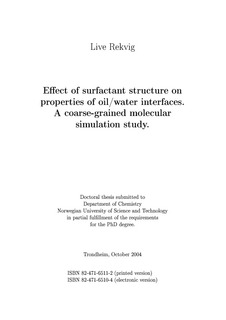| dc.contributor.author | Rekvig, Live | nb_NO |
| dc.date.accessioned | 2014-12-19T13:20:37Z | |
| dc.date.available | 2014-12-19T13:20:37Z | |
| dc.date.created | 2004-11-01 | nb_NO |
| dc.date.issued | 2004 | nb_NO |
| dc.identifier | 124928 | nb_NO |
| dc.identifier.isbn | 82-471-6510-4 | nb_NO |
| dc.identifier.uri | http://hdl.handle.net/11250/247458 | |
| dc.description.abstract | The elastic properties of oil/water/surfactant interfaces play an important role in the phase behaviour of microemulsions and for the stability of macroemulsions. The aim of this thesis is to obtain an understanding of the relationship between the structure of the surfactant molecules, the structure of the interface, and macroscopic interfacial properties. To achieve this aim, we performed molecular simulations of oil/water/surfactant systems. We made a quantitative comparison of various model surfactants to determine how structural changes affect interfacial properties and film rupture. The model consists of water, oil, head, and tail beads, and surfactants are constructed by coupling head and tail beads with harmonic springs. We used a hybrid dissipative particle dynamics-Monte Carlo scheme. The former was used to simulate particle trajectories and the Monte Carlo scheme was used to mimic experimental conditions: bulk-interface phase equilibrium, tensionless interfaces in microemulsions, and the surface force apparatus.
A detailed comparison of various non-ionic model surfactants showed how structural changes affect interfacial properties:
Comparison between linear and branched surfactants showed that the efficiency of adsorption is higher for linear surfactants, although branched surfactants are more efficient at a given surface density. Linear surfactants can be more efficient also at the same surface density if the head group is sufficiently soluble in oil, because low head-oil repulsion makes the branched isomers stagger at the interface. The bending rigidity is higher for linear surfactants. Furthermore, branched surfactants make oil droplets coalesce more easily than linear surfactants do, but linear and branched surfactants have roughly the same effect on water droplet coalescence.
Comparison of linear surfactants with varying chain lengths showed that longer surfactants have a lower surface tension and higher bending rigidity. The increase in rigidity with chain length follows a power law, but the exponent is higher for surfactant monolayers at a fixed density than at a fixed tension. Longer tails and/or denser monolayers influence the stability of water droplets in a positive direction, and the stability of oil droplets in a negative direction.
Addition of cosurfactant showed that mixed monolayers have a lower bending rigidity than pure monolayers at the same average chain length and tension. Cosurfactants have a negative effect on the stability of water droplets, and a positive effect on the stability of oil droplets. | nb_NO |
| dc.language | eng | nb_NO |
| dc.publisher | Fakultet for naturvitenskap og teknologi | nb_NO |
| dc.relation.ispartofseries | Doktoravhandlinger ved NTNU, 1503-8181; 2004:142 | nb_NO |
| dc.relation.haspart | Rekvig, L; Kranenburg, M; Hafskjold, B; Smit, B. Effect of surfactant structure on interfacial properties. Europhys. Lett.. 63: 902-907, 2003. | nb_NO |
| dc.relation.haspart | Rekvig, L; Kranenburg, M; Vreede, J; Hafskjold, B; Smit, B. Investigation of surfactant efficiency using dissipative particle dynamics. Langmuir. 19(20): 8195-8205, 2003. | nb_NO |
| dc.relation.haspart | Rekvig, L; Hafskjold, B; Smit, B. Simulating the effect of surfactant structure on bending moduli of monolayers. J. Chem. Phys. 120(10): 4897-4905, 2004. | nb_NO |
| dc.relation.haspart | Rekvig, L; Hafskjold, B; Smit, B. Chain length dependencies of the bending modulus of surfactant monolayers. Phys. Rev.Lett. 92: 116101, 2004. | nb_NO |
| dc.subject | Surfactants | en_GB |
| dc.subject | amphiphiles | en_GB |
| dc.subject | oil/water interfaces | en_GB |
| dc.subject | molecular simulations | en_GB |
| dc.subject | dissipative particle dynamics | en_GB |
| dc.subject | emulsions | en_GB |
| dc.subject | emulsion stability | en_GB |
| dc.subject | surface tension | en_GB |
| dc.subject | bending modulus | en_GB |
| dc.subject | Chemistry | en_GB |
| dc.subject | NATURAL SCIENCES: Chemistry | en_GB |
| dc.title | Effect of surfactant structure on properties of oil/water interfaces: A coarse-grained molecular simulation study. | nb_NO |
| dc.type | Doctoral thesis | nb_NO |
| dc.contributor.department | Norges teknisk-naturvitenskapelige universitet, Fakultet for naturvitenskap og teknologi, Institutt for kjemi | nb_NO |
| dc.description.degree | PhD i kjemi | nb_NO |
| dc.description.degree | PhD in Chemistry | en_GB |
